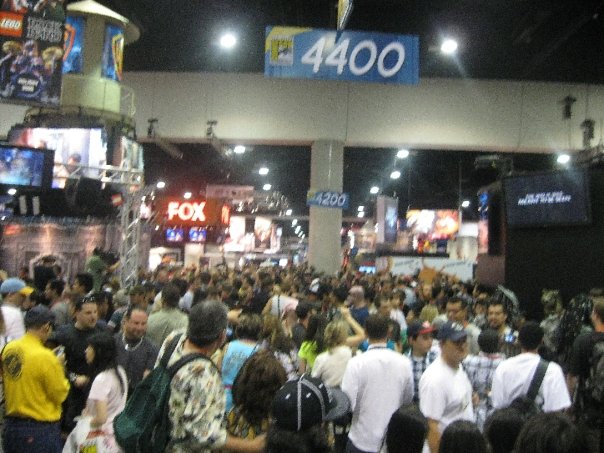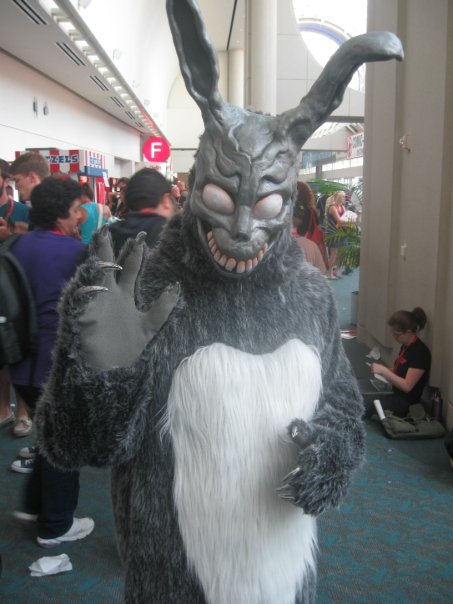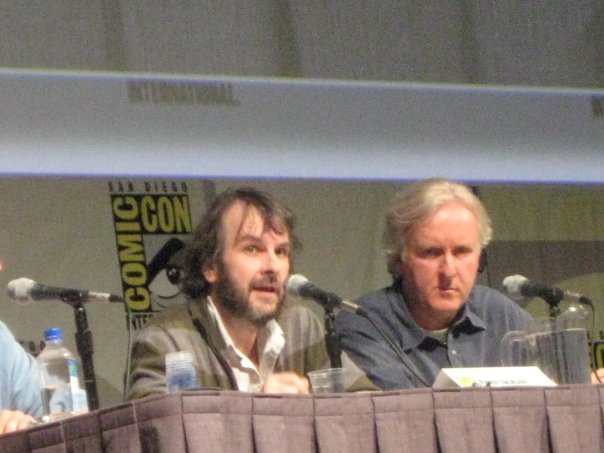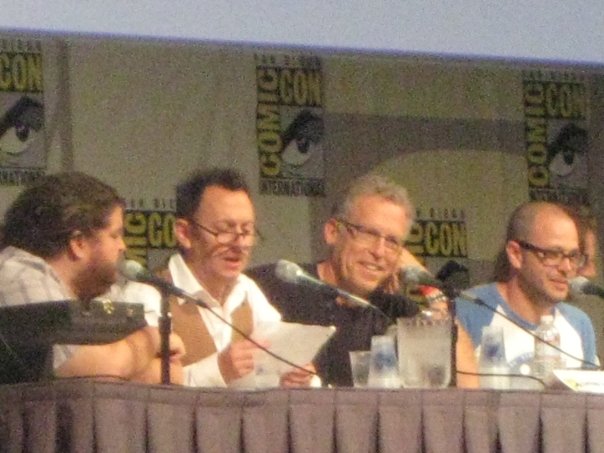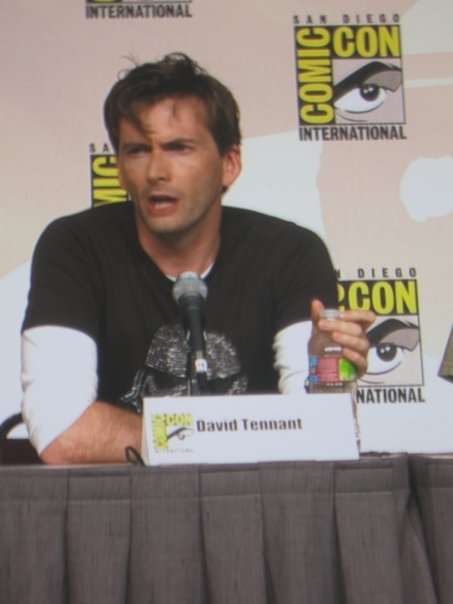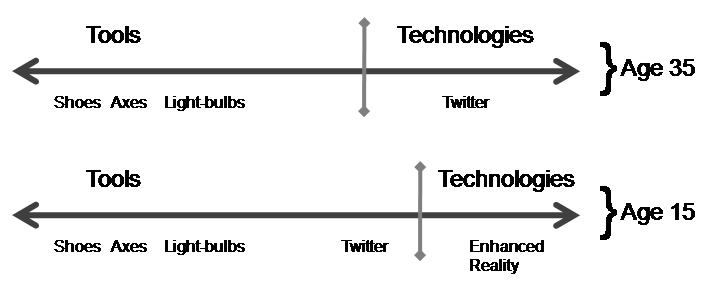Given the interest out there in transmedia or cross-media entertainment, I thought I would share the syllabus for the course I am teaching this fall at the University of Southern California. I am still shifting some details, as I deal with the scheduling of guest speakers, but all of the speakers listed have agreed to come. The readings are a good starter set for people wanting to do more thinking on this emerging area of research. I will be sharing reflections about the course material here throughout the fall, since I'm sure working through these readings in a class context is going to spark me to do some fresh thinking on the topic. I'd love to hear from others out there teaching transmedia or cross-media topics.
If you know someone at USC who you think might want to take this class, let them know. I still have room for more students.
Course Description and Outcomes:
We now live at a moment where every story, image, brand, relationship plays itself out across the maximum number of media platforms, shaped top down by decisions made in corporate boardrooms and bottom up by decisions made in teenager's bedrooms. The concentrated ownership of media conglomerates increases the desirability of properties that can exploit "synergies" between different parts of the medium system and "maximize touch-points" with different niches of consumers. The result has been the push towards franchise-building in general and transmedia entertainment in particular.
A transmedia story represents the integration of entertainment experiences across a range of different media platforms. A story like Heroes or Lost might spread from television into comics, the web, computer or alternate reality games, toys and other commodities, and so forth, picking up new consumers as it goes and allowing the most dedicated fans to drill deeper. The fans, in turn, may translate their interests in the franchise into concordances and wikipedia entries, fan fiction, vids, fan films, cosplay, game mods, and a range of other participatory practices that further extend the story world in new directions. Both the commercial and grassroots expansion of narrative universes contribute to a new mode of storytelling, one which is based on an encyclopedic expanse of information which gets put together differently by each individual consumer as well as processed collectively by social networks and online knowledge communities.
The course is broken down into five basic units: "Foundations" offers an overview of the current movement towards transmedia or cross-platform entertainment; "Narrative Structures" introduces the basic toolkit available to contemporary storytellers, digging deeply into issues around seriality, and examining what it might mean to think of a story as a structure of information; "World Building" deals with what it means to think of contemporary media franchises in terms of "worlds" or "universes" which unfold across many different media systems; "Audience Matters" links transmedia storytelling to issues of audience engagement and in the process, considers how fans might contribute unofficial extensions to favorite media texts; and "Tracing the History of Transmedia" pulls back to consider key moments in the evolution of transmedia entertainment, moving from the late 19th century to the present.
In this course, we will be exploring the phenomenon of transmedia storytelling through:
• Critically examining commercial and grassroots texts which contribute to larger media franchises (mobisodes and webisodes, comics, games).
• Developing a theoretical framework for understanding how storytelling works in this new environment with a particular emphasis upon issues of world building, cultural attractors, and cultural activators.
• Tracing the historical context from which modern transmedia practices emerged, including consideration of the contributions of such key figures as P.T. Barnum, L. Frank Baum, Feuillade, C.S. Lewis, J.R.R. Tolkien, Cordwainer Smith, Walt Disney, George Lucas, DC and Marvel Comics, and Joss Whedon.
• Exploring what transmedia approaches contribute to such key genres as science fiction, fantasy, horror, superhero, suspense, soap opera, teen and reality television.
• Listening to cutting-edge thinkers from the media industry talk about the challenges and opportunities which transmedia entertainment offers, walking through cases of contemporary projects that have deployed cross-platform strategies.
• Putting these ideas into action through working with a team of fellow students to develop and pitch transmedia strategies around an existing media property.
Required Books:
Pat Harrington and Noah Wardrip-Fruin, Third Person: Authoring and Exploring Vast Narratives (Cambridge: MIT Press, 2009), 636 pages.
Kim Deitch, Alias the Cat (New York: Pantheon, 2007), 136 pages.
Kurt Busiek and Alex Ross, Marvels (Marvel Comics, 2003), 216 pages.
Kevin J. Anderson (ed.), Tales from the Mos Eisley Cantina (New York: Spectra, 1995),
416 pages.
Joss Whedon, The Long Way Home (New York: Dark Horse, 2007), 136 pages.
All additional readings will be provided through the Blackboard site for the class.
Grading and Assignments:
Commercial Extension Paper 20 percent
Grassroots Extension Paper 20 percent
Final Project - Franchise Development Project 40 percent
Class Forums 20 percent
In order to fully understand how transmedia entertainment works, students will be expected to immerse themselves into at least one major media franchise for the duration of the term. You should consume as many different instantiations (official and unofficial) of this franchise as you can and try to get an understanding of what each part contributes to the series as a whole.
COMMERCIAL EXTENSION PAPER: For the first paper, you will be asked to write a 5-7 page essay examining one commercially produced media extension (comic, website, game, mobisode, amusement park attraction, etc.). You should try to address such issues as its relationship to the story world, its strategies for expanding the narrative, its deployment of the distinctive properties of its platform, its targeted audience, and its cultural attractors/activators. (Due Sept. 23)(20 Percent)
GRASSROOTS EXTENSION PAPER: For the second paper, you will be asked to write a 5-7 page essay examining a fan-made extension (fan fiction, discussion list, video, etc.) and try to understand where the audience has sought to attach themselves to the franchise, what they add to the story world, how they respond to or route around the invitational strategies of the series, and how they reshape our understanding of the characters, plot or world of the original franchise. (Due Nov. 18) (20 Percent)
FINAL PROJECT - FRANCHISE DEVELOPMENT PROJECT: Students will be organized into teams, which for the purpose of this exercise will function as transmedia companies. You should select a media property (a film, television series, comic book, novel, etc.) that you feel has the potential to become a successful transmedia franchise. In most cases, you will be looking for a property that has not yet added media extensions, though you could also look at a property that you feel has been mishandled in the past. By the end of the term, your team will be "pitching" this property. The pitch should include a briefing book that describes:
1) the core defining properties of the property
2) a description of the intended audience(s)
3) a discussion of the specific plans for each media platform you are going to deploy
4) an overall description for how you will seek to integrate the different media platforms to create a coherent world
5) a business plan which includes likely costs and revenue and the time table for rolling out the various media elements
6) parallel examples of other properties which have deployed the strategies being described
The pitch itself will be a 20 minute group presentation, followed by 10 minutes of questioning. The presentation should give us a "taste" of what the property is like as well as to lay out some of the key elements that are identified in the briefing book. For an example of what these pitches might look like, watch the materials assembled at http://www.educationarcade.org/SiDA/videos, which shows how a similar activity was conducted at MIT. Each member of the team will be expected to develop expertise around a specific media platform as well as to contribute to the over-all strategies for spreading the property across media systems. The group will select its own team leader who will be responsible for contacts with the instructor and will coordinate the presentation. The team leader will be asked to provide feedback on what each team member contributed to the effort, while team members will be asked to provide an evaluation of how the team leader performed. Team Members will check in with the instructor on Week Ten and Week Fourteen to review their progress on the assignment. Presentation (Dec.7, 9) Briefing Book (Dec. 14) (40 Percent)
CLASS FORUM: For each class session, students will be asked to contribute a substantive question or comments via the class forum on BlackBoard. Comments should reflect an understanding of the readings for that day as well as an attempt to formulate an issue that we can explore through class discussions or with the visiting speakers. (20 Percent)
Class Schedule:
*Guest Speakers are tentative, subject to availability. Shifts in speakers and thus topics and readings may occur after the semester starts.
Part One: Foundations
Week 1
August 24: Transmedia Storytelling 101
Henry Jenkins, "Transmedia Storytelling 101" Confessions of an Aca-Fan, http://henryjenkins.org/2007/03/transmedia_storytelling_101.html
Henry Jenkins, "Searching for the Origami Unicorn: The Matrix and Transmeda Storytelling," Convergence Culture: Where Old and New Media Collide (New York: New York University Press, 2006), pp. 93-130.
Geoff Long, "What Is Transmedia Storytelling", Transmedia Storytelling: Business, Aesthetics and Production at the Jim Henson Company, pp. 13-69.
August 26 Intertextual Commodities?
P. David Marshall, "The New Intertextual Commodity" in Dan Harries (ed.) The New Media Book (London: BFI, 2002), pp. 69-81.
Derek Johnson, "Intelligent Design or Godless Universe? The Creative Challenges of World Building and Franchise Development," Franchising Media Worlds: Content Networks and The Collaborative Production of Culture, PhD Dissertation, University of Wisconsin-Madison, 2009. pp.170-279.
Watch:
Battlestar Galactica: The Face of the Enemy
Week 2
August 31: Media Mix in Japan
Anne Allison, "Pokemon: Getting Monsters and Communicating Capitalism," Millennial Monsters: Japanese Toys and the Global Imagination (Berkeley: University of California Press, 2006), pp. 192-233.
David Buckingham and Julian Sefton-Green, "Structure, Agency and Pedagogy in Children's Media Culture" In Joseph Tobin (ed.) Pikachu's Global Adventure: The Rise and Fall of Pokemon (Durham: Duke University Press, 2004), pp. 12-33.
Mizuko Ito, "Gender Dynamics of the Japanese Media Mix," Beyond Barbie and Mortal Kombat: New Perspectives on Gender and Gaming (Cambridge, MIT, 2008), pp. 97-110.
September 2: Toys and Tales
Jeff Gomez, "Creating Blockbuster Worlds" (unpublished)
Henry Jenkins, "Talking Transmedia: An Interview with Starlight Runner's Jeff Gomez," Confessions of an Aca-Fan, http://www.henryjenkins.org/2008/05/an_interview_with_starlight_ru.html
Mark Federman, "What is the Meaning of the Medium is the Message," http://individual.utoronto.ca/markfederman/article_mediumisthemessage.htm
Guest Speakers:
Jeff Gomez, Starlight Runner
Jordan Greenhill, DivX
Week 3
September 7 is the Labor Day holiday
September 9: Transmedia Branding
Faris Yacob, "I Believe Children are the Future," http://www.slideshare.net/NigelG/ipa-thesis-i-believe-the-children-are-our-future
Henry Jenkins, "How Transmedia Storytelling Begat Transmedia Planning...", Confessions of an Aca-Fan, http://henryjenkins.org/2006/12/how_transmedia_storytelling_be.html
http://henryjenkins.org/2006/12/how_transmedia_storytelling_be_1.html
Guest Speaker: Faris Yacob, McCann Erickson New York
Week 4
September 14 Heroes and Alchemists: The New Storytelling
The 9th Wonders, Chapters 1-9 http://www.nbc.com/Heroes/novels/novels_library.shtml?novel=9
Henry Jenkins, "We Had So Many Stories to Tell': The Heroes Comics as Transmedia Storytelling," Confessions of an Aca-Fan, http://henryjenkins.org/2007/12/we_had_so_many_stories_to_tell.html
Carolyn Handler Miller, Digital Storytelling: A Creator's Guide to Interactive Entertainment (Amsterdam: Focal Press, 2006), "Using a Transmedia Approach", pp. 149-164 (Rec.)
Guest Speakers: Mauricio Mota, Mark Warshaw, Here Come the Alchemists
Part Two: Narrative Structures
September 16: Seriality
Angela Ndalianis, Neo-Baroque Aesthetics and Contemporary Entertainment (Cambridge: MIT Press, 2004), "Polycentrism and Seriality: (Neo-)Baroque Narrative Formation," pp. 31-70.
Jason Mittell, "All in the Game: The Wire, Serial Storytelling and Procedural Logic" (Harrington and Wardrip-Fruin, pp. 429-438.
Watch:
The Wire
http://www.amazon.com/Wire-Complete-Fourth-Season/dp/B000QXDJLI/ref=pd_bbs_sr_1?ie=UTF8&s=dvd&qid=1197321529&sr=8-1
"Young Prop Joe"
"Bunk and McNulty"
"Young Omar"
Jennifer Haywood, Consuming Pleasures: Active Audiences and Serial Fictions from Dickens to Soap Opera (University of Kentucky Press, 1997), "Mutual Friends: The Development of the Mass Serial," pp. 21-51. (rec)
Week 5
September 21: Soaps Go Transmedia
Sharon Marie Ross, "Managing Millennials: Teen Expectations of Tele-Participation," Beyond the Box: Television and the Internet (London: Blackwell, 2008), pp. 124-172.
Sam Ford, "From Oakdale Confidential to L.A. Diaries: Transmedia Storytelling for ATWT," As the World Turns in a Convergence Culture (Master's Thesis), pp. 141-162.
Louisa Stein, "Playing Dress Up: Digital Fashion and Game Extensions of Televisual Experience in Gossip Girl's Second Life," Cinema Journal, pp. 116-122.
Watch:
Gossip Girl: Tales From the Upper East Side
http://www.cwtv.com/thecw/gossip-girl-tales-from-the-upper-east-side
LA Diaries
http://www.cbs.com/daytime/specials/la_diaries/episodes.php
September 23: Creating Alternate Realities
Christy Dena, "Emerging Participatory Culture Practices: Player-Created Tiers in Alternate Reality Games," Convergence, February 2008, pp. 41-58.
Jane McGonigal, Why I Love Bees: A Case Study in Collective Intelligence Gaming." Ecologies of Play. Ed. Katie Salen. (Cambridge: MIT Press, 2008), pp. 199-228. http://www.mitpressjournals.org/doi/pdfplus/10.1162/dmal.9780262693646.199
Dave Szulborski, "Puppetmastering: Creating a Game" and "Puppetmastering: Running a Game,"This Is Not A Game: A Guide to Alternate Reality Gaming (New York: New Fiction, 2005), pp. 207-284.
Guest Speaker: Evan Jones, Stitch Media
COMMERCIAL EXTENSION PROJECT DUE
Week 6
September 28: Speaking of Serials
Kim Deitch, Alias the Cat (New York: Pantheon, 2007) (Required Book)
David Kalat, "The Long Arm of Fantomas" (Harrington and Wardrip-Fruin), pp. 211-225.
September 30: The Unfolding Text
Neil Perryman, "Doctor Who and the Convergence of Media: A Case Study in Transmedia Storytelling," Convergence, February 2008, pp. 21-40.
Lance Perkin,"Truths Universally Acknowledged: How the 'Rules' of Doctor Who Affect the Writing," (Harrington and Wardrip-Fruin), pp. 13-24.
Matt Hills, "Absent Epic, Implied Story Arcs, and Variations on a Narrative Theme: Doctor Who (2005) as Cult/Mainstream TV," (Harrington and Wardrip-Fruin), pp. 333-343.
Part Three: World-Building
Week 7
October 5: Migratory Characters
William Uricchio and Roberta E. Pearson, "I'm Not Fooled By That Cheap Disguise," in Roberta E. Pearson, The Many Lives of the Batman: Critical Approaches to A Superhero and His Media (New York: Routledge, 1991), pp. 182-213.
Will Brooker, "Establishing the Brand: Year One," Batman Unmasked: Analyzing a Cultural Icon (London: Continuium, 2001), pp. 36-67.
Bob Kane, "The Legend of the Batman" (1938) and Bob Kane, "The Origins of the Batman," (1948) in Dennis O'Neil (ed.) The Secret Origins of the DC Superheroes (New York: DC, 1976), pp. 36-50.
Bob Kane, "The First Batman" (1956) and Dennis O'Neil, "There Is No Hope in Crime Alley," (1978) The Greatest Batman Stories Ever Told (New York: DC, 1988).
Guest Speaker: Geoffrey Long, GAMBIT
October 7: World Building in Comics
Matthew J. Pustz, Comic Book Culture: Fanboys and True Believers (Jackson: University of Mississippi Press, 1999), pp. 129-133.
Jason Bainbridge, "Worlds Within Worlds: The Role of Superheroes in the Marvel and DC Universe," Angela Ndalianis (ed.), The Contemporary Comic Book Superhero (New York: Routledge, 2008) pp. 64-85.
Sam Ford and Henry Jenkins, "Managing Multiplicity in Superhero Comics," (Harrington and Wardrip-Fruin), pp. 303-313.
Kurt Busiek and Alex Ross, Marvels (New York: Marvel Comics, 1993) (Required Book)
Alec Austin, "Hybrid Expectations, Expectations Across Media, CMS Thesis, pp. 97-127.
Week 8
October 12: Who Watches the Watchman?
Stuart Moulthrop, "See the Strings: Watchmen and the Under-Language of Media" (Harrington and Wardrip-Fruin), pp. 287-303.
Watch:
NBS Nightly News With Ted Philips http://www.youtube.com/watch?v=nd5cInmK6LQ&playnext_from=PL&feature=PlayList&p=878F6464EEBE32F9&index=10
The Keene Act and YOU http://www.youtube.com/watch?v=qkWGZ1G7TAE&playnext_from=PL&feature=PlayList&p=878F6464EEBE32
Saturday Morning Watchmen
http://www.youtube.com/watch?v=YDDHHrt6l4w
Guest Speaker: Alex McDowell, Production Designer, Watchmen
October 14: World Building in Science Fiction
Walter Jon Williams, "In What Universe?" (Harrington and Wardrip-Fruin), pp. 25-32.
George R.R. Martin, "On the Wild Cards Novels," in Pat Harrington and Wardrip-Fruin (eds.) Second Person: Role-Playing and Story in Games and Playable Media (Cambridge: MIT Press, 2007).
Cordwainer Smith, "The Dead Lady of Clown Town," and "The Ballad of Lost C'mell," J. J. Pierce (ed.) The Best of Cordwainer Smith (New York: Del Rey, 1975), pp. 124-209, pp. 315-337.
Week 9
October 19: Launching a New World
David Lavery, "Lost and Long-Form Television Narrative" (Harrington and Wardrip-Fruin),
pp. 313-323.
Guest Speaker: Jesse Alexander, Executive Producer, Year One
October 21: Transmedia and Social Change
TBA
Guest Speaker: Bram Pitoyo, Wild Alchemy
Part Four: Audiences
Week 10
October 26: The Logic of Engagement
Ivan Askwith, "The Expanded Television Text, "Five Logics of Engagement,"; "Lost at Televisions' Crossroads," Television 2.0: Reconceptualizing TV as an Engagement Medium, CMS thesis, pp. 51-150.
Guest Speaker: Ivan Askwith, Big Space Ship
October 28: Expanding the Audience
Kim Moses and Ian Sander, selections from Ghost Whisperer: The Spirit Guide (New York: Titan Books, 2008).
Guest Speaker: Kim Moses, Executive Producer, The Ghost Whisperer
Week 11
November 2: Fan Productivity
Jesse Walker, "Remixing Television: Francesca Coppa on the Vidding Underground," Reason, August/September 2008, http://www.reason.com/news/show/127432.html
Francesca Coppa, "Women, Star Trek, and the Early Development of Fannish Vidding," Transformative Works and Cultures (2008), http://journal.transformativeworks.org/index.php/twc/article/view/44/64
Bud Caddell, "Becoming a Mad-Man," http://drop.io/becomingamadman
November 4: The Encyclopedic Impulse
Janet Murray, "Digital Environments are Encyclopedic," Hamlet on the Holodeck: The Future of Narrative in Cyberspace (Cambridge: MIT Press, 1997), pp. 83-90.
Bob Rehak, "That Which Survives: Star Trek's Design Network in Fandom and Franchise" (Unpublished), pp. 2-79.
Robert V. Kozinets, "Inno-Tribes: Star Trek as Wikimedia" Consumer Tribes (London: Butterworth-Heinemann, 2007), pp. 194-209.
Watch:
Star Trek: Phase II "In Harms Way"
http://www.startreknewvoyages.com/episodes.html
Week 12
November 9: The Power of Details
Kristin Thompson, "Not Your Father's Tolkien" and "Interactive Middle Earth," The Frodo Franchise: The Lord of the Rings and Modern Hollywood (Berkeley: University of California Press, 2007), pp.53-74, p. 224-256
C.S. Lewis, "On Stories," Of Other Worlds: Essays and Stories (New York: Harvest, 2002), pp. 3-21.
November 11: Ephemeral Fascinations
Michael Bonesteel, "Henry Darger's Search for the Grail in the Guise of a Celesttial Child" (Harrington and Wardrip-Fruin), pp. 253-267.
Amelie Hastie, "The Collector: Material Histories, Colleen Moore's Dollhouse, and Ephemeral Recollection," Cupboards of Curiosity: Women, Recollection, and Film History (Durham: Duke University Press, 2007), pp. 19-72.
Week 13
November 16 Independent Horrors
James Castonguay, "The Political Economy of the Indie Blockbuster: Fandom, Intermediality, and The Blair Witch Project," in Sarah L. Higley and Jeffrey Andrew Weinstock (eds.) Nothing That Is: Milllennial Cinema and the Blair Witch Controversies (Detroit: Wayne State University, 2004), pp. 65-86.
The Blair Witch Project Website http://www.blairwitch.com/
Head Trauma Website http://www.headtraumamovie.com/
Guest Speaker: Lance Weiller, Head Trauma
Part Five: Tracing the History of Transmedia
November 18: Before the Rainbow
Neil Harris, "The Operational Aesthetic," Humbug: The Art of P.T. Barnum (Chicago: University of Chicago Press, 1973), pp. 59-90.
Mark Evan Swartz, "A Novel Enchantment," Before the Rainbow: L. Frank Baum's The Wonderful Wizard of Oz on Stage and Screen to 1939 (Baltimore: Johns Hopkins University Press, 2000), pp. 161-172.
Week 14
November 23: What Uncle Walt Taught Us
J.P. Telotte, Disney TV (Detroit: Wayne State, 2004), pp. 1-91.
Karal Ann Marling, "Imagineering the Disney Theme Parks," in Karal Ann Marling (ed.) Designing Disney's Theme Parks: The Architecture of Reassurance (Montreal: Centre Canadian d'Architecture, 1997), pp. 29-178. (Rec.)
November 25: Franchises and Attractions
Henry Jenkins, "The Pleasure of Pirates And What It Tells Us About World Building in Branded Entertainment", Confessions of an Aca-Fan, http://henryjenkins.org/2007/06/forced_simplicity_and_the_crit.html
Don Carson, "Environmental Storytelling: Creating Immersive 3D Worlds Using Lessons Learned from the Theme Park industry," Gamasutra, http://www.gamasutra.com/features/20000301/carson_pfv.htm
Week 15
November 30: Lessons From Lucas
Jonathon Gray, "Learning to Use the Force: Star Wars Toys and Their Films," Show Sold Separately (Forthcoming), pp. 232-247.
Will Brooker, Using the Force: Creativity, Community and Star Wars Fans (New York: Continuum, 2002), "The Fan Betrayed," pp. 79-99, "Canon," pp. 101-114.
Kevin J. Anderson (ed.), Tales from the Mos Eisley Cantina (New York: Spectra, 1995) (Required Book)
December 2: Across the Whedonverse
Tanya Krzywinska, "Arachne Challenges Minerva: The Spinning Out of Long Narrative in World of Warcraft and Buffy the Vampire Slayer" (Harrington and Wardrip-Fruin), pp. 385-399.
Joss Whedon, The Long Way Home (New York: Dark Horse, 2007) (Required Book)
Watch:
Dr. Horrible's Sing-Along Blog
http://www.hulu.com/watch/28343/dr-horribles-sing-along-blog
December 7 Student Presentations
December 9 Student Presentations

![Reblog this post [with Zemanta]](http://img.zemanta.com/reblog_e.png?x-id=831538e2-b9a8-4ae0-8fb8-a42f2c766d03)
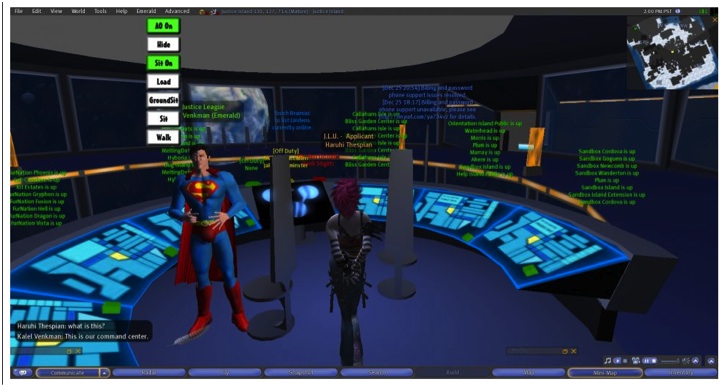
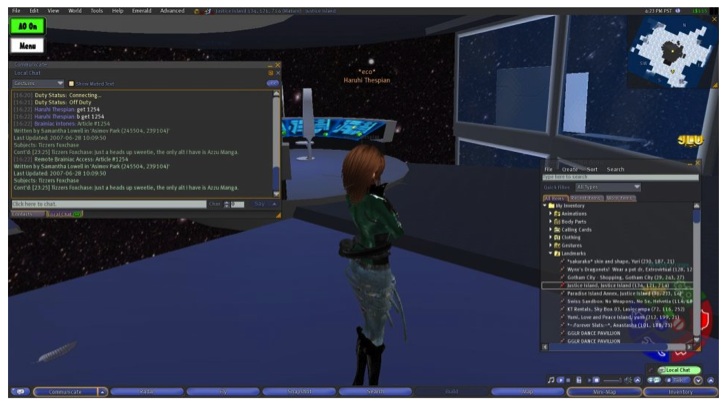

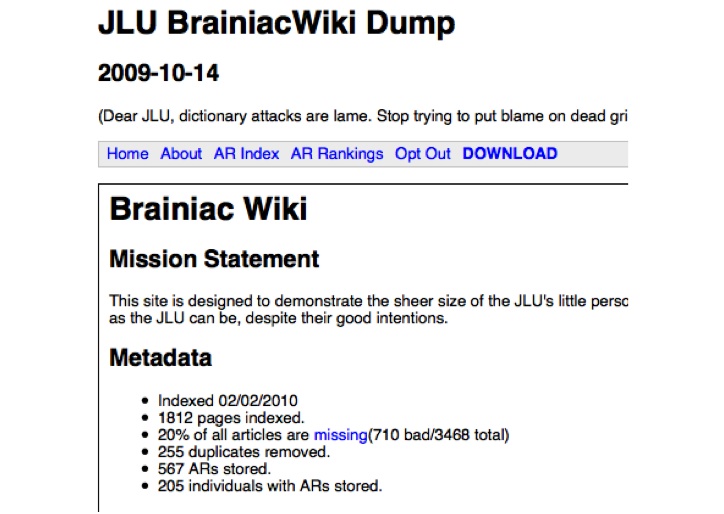

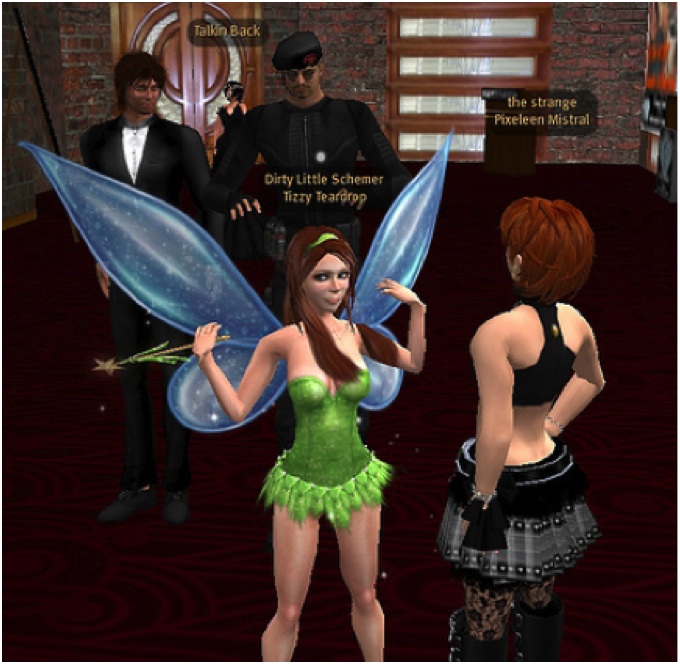
![Reblog this post [with Zemanta]](http://img.zemanta.com/reblog_e.png?x-id=185a3a03-6241-46e9-8e94-94f87355ac95)
